|
|
||||||||||||||||||||||||||||||||||||||||||||||||||||||||||
|
Please sign my Guestbook and leave feedback |
||||||||||||||||||||||||||||||||||||||||||||||||||||||||||
|
Recent Additions |
||||||||||||||||||||||||||||||||||||||||||||||||||||||||||
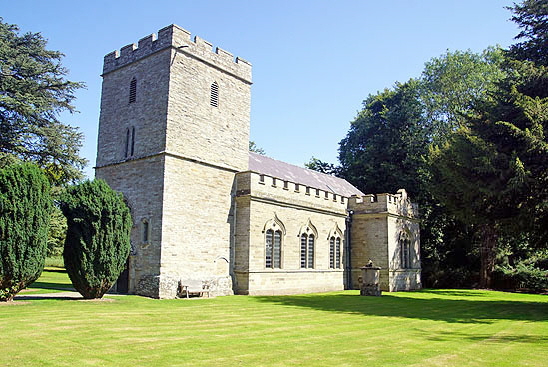 |
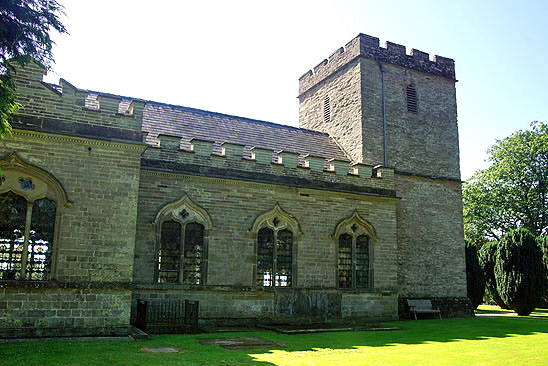 |
||||||||||||||||||||||||||||||||||||||||||||||||||||||||||||||||||||
|
Left and Right: The church from respectively the south west and the the north. The tower is Norman although, as we shall see, its west side has been extensively changed. As you would expect, the north and south sides are symmetrical. Each window spaces has an ogee arch profile with a quatrefoil cut into the head - two in the case of the transept windows. Battlements were evidently still a la mode, |
|||||||||||||||||||||||||||||||||||||||||||||||||||||||||||||||||||||
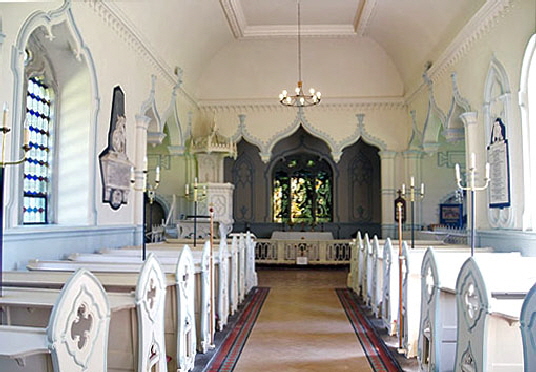 |
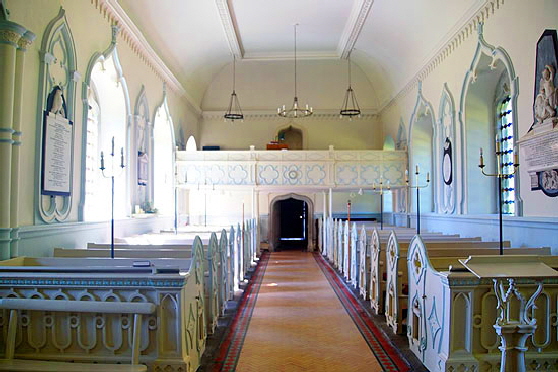 |
||||||||||||||||||||||||||||||||||||||||||||||||||||||||||||||||||||
|
Left: Nothing really prepares you for the interior here: the exterior could just as easily be a barmy Victorian neo-Gothic confection. Ogee arches are ubiquitous including the pretty “chancel arch” and the symmetrical chapel arches to north and south. All is cream lined with sky blue lining. Right: the View to the west. The west gallery would have been more or less de rigeur at this time. Note the decorative mouldings throughout the church. |
|||||||||||||||||||||||||||||||||||||||||||||||||||||||||||||||||||||
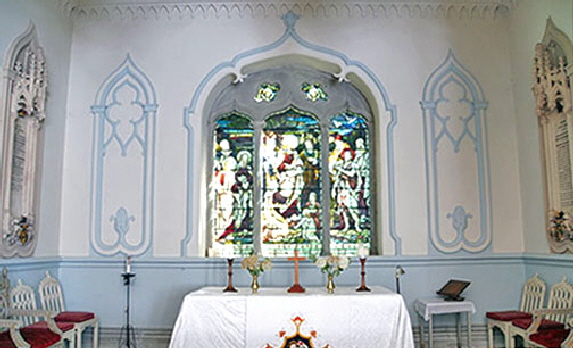 |
|||||||||||||||||||||||||||||||||||||||||||||||||||||||||||||||||||||
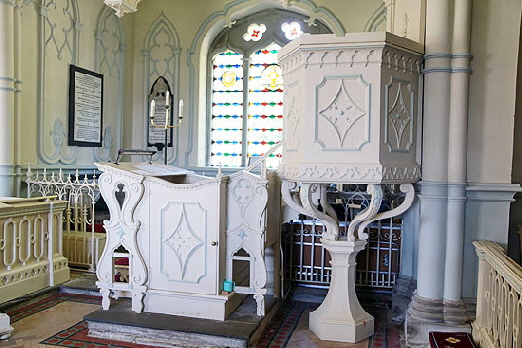 |
|||||||||||||||||||||||||||||||||||||||||||||||||||||||||||||||||||||
|
Left: The chancel. The pretty (but somewhat incongruous?) decorative designs at each side of the east window are seen throughout the church. Right: The reading desk and pulpit are perhaps the most attractive features of the church. The delicate “supports” for the pulpit are nothing of the sort: they would be incapable of bearing the weight. |
|||||||||||||||||||||||||||||||||||||||||||||||||||||||||||||||||||||
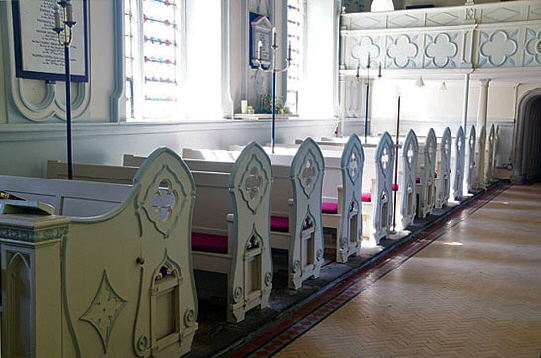 |
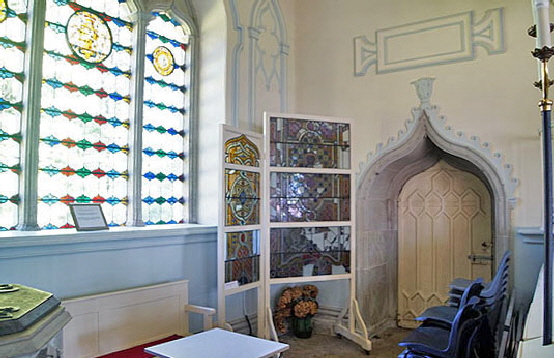 |
||||||||||||||||||||||||||||||||||||||||||||||||||||||||||||||||||||
|
Left: The south side of the nave, showing the flashy - there’s no other word for them - benches. Right: Inside the shallow north transept is a display of stained glass that was part of the original east window that was replaced in 1907. The modern font can just be glimpsed in the bottom left hand corner. The doorway to the vestry is rather gorgeous although the rectangular decorative device above it looks a little random. |
|||||||||||||||||||||||||||||||||||||||||||||||||||||||||||||||||||||
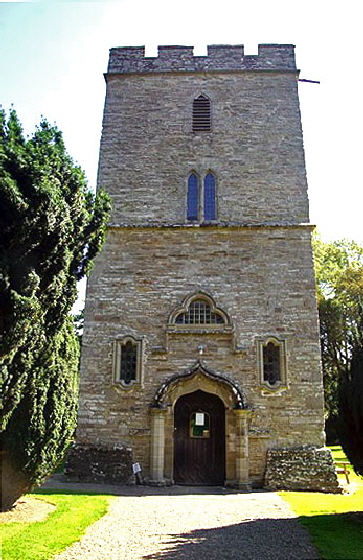 |
|||||||||||||||||||||||||||||||||||||||||||||||||||||||||||||||||||||
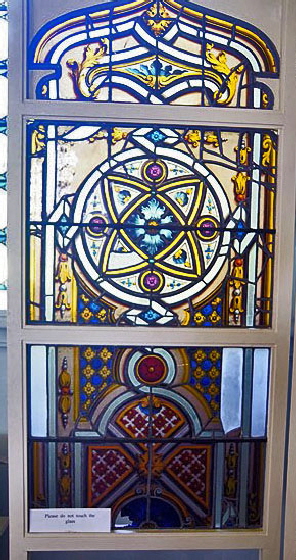 |
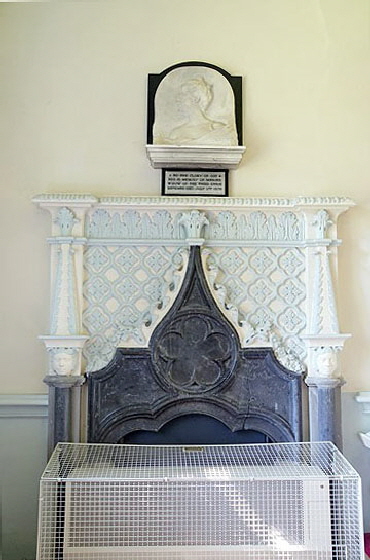 |
||||||||||||||||||||||||||||||||||||||||||||||||||||||||||||||||||||
|
Left: Some of the original east window glass. For my money it is much more attractive than the nasty mass-produced biblical scenes that replaced it. Perhaps the Edwardians thought there should be a bit more God on view in this showy building? The original glass was painted by William Price the Younger of London, whom the Church Guide claims to have been the finest glass painter of the eighteenth century. Centre: Yes, that is a fireplace lurking in the south transept! The Bateman family sat here and wanted some creature comforts. Their less fortunate servants were housed in the (colder) north transept and there was no fireplace for them. Right: The Norman tower from the west. The windows and bell openings on the upper stage shows you that it is older than the rest of the church. For my money this west wall is one part of the rebuilding that doesn’t “work”. The incomplete trefoil window looks unfinished and it sits over a rather odd rectangular hood mould. To the left and right are peculiarly-shaped windows that cross the border into self-indulgence, in my view. The ogee-shaped west door, on the other hand, works well. The whole composition looks a little bit like it was designed by a committee - maybe it was the “Committee of Taste” that was responsible? |
|||||||||||||||||||||||||||||||||||||||||||||||||||||||||||||||||||||
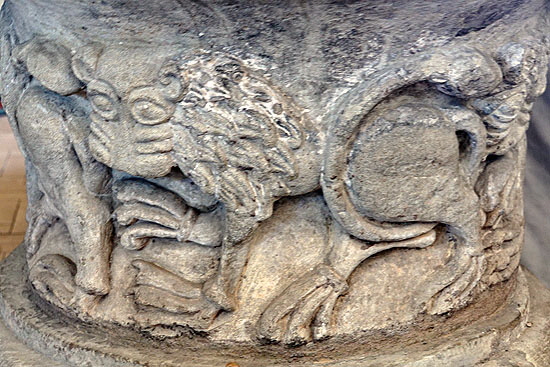 |
|||||||||||||||||||||||||||||||||||||||||||||||||||||||||||||||||||||
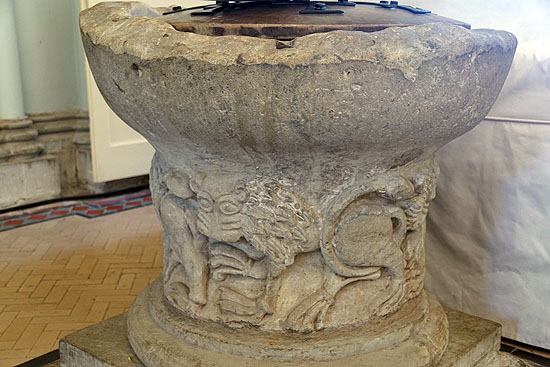 |
|||||||||||||||||||||||||||||||||||||||||||||||||||||||||||||||||||||
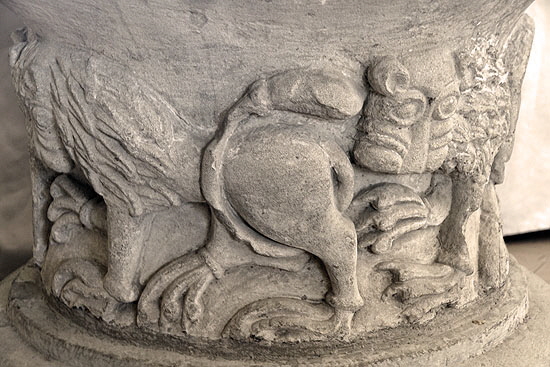 |
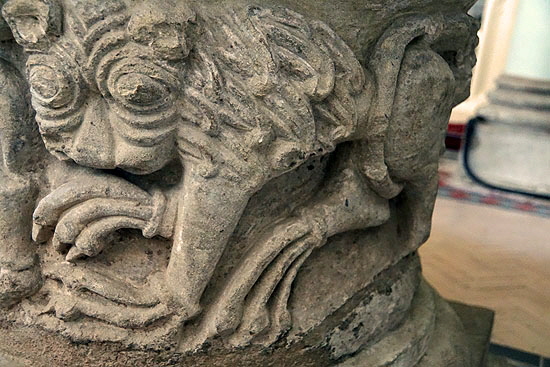 |
||||||||||||||||||||||||||||||||||||||||||||||||||||||||||||||||||||
|
Four Pictures Above: Four views of the Romanesque font, the work of the Herefordshire School. The bowl is decorated solely with lions and these lions can be seen in many other pieces by the School - and we will see them again on the Shobdon arches. They are not the finest sculptures by the School but the sheer brio is exhilarating. All of the lions have just three claws on each leg. The faces, in fact, are not just unmistakable within the context of the Herefordshire School: their vigorously lined faces and large staring eyes can be seen on many a Romanesque corbel table. |
|||||||||||||||||||||||||||||||||||||||||||||||||||||||||||||||||||||
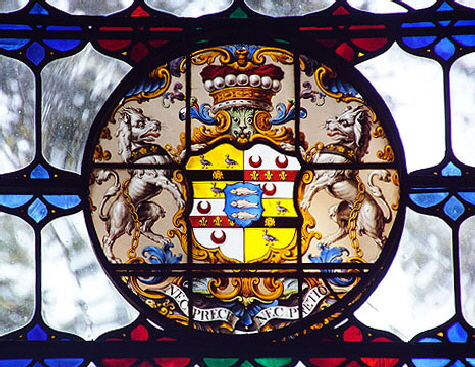 |
|||||||||||||||||||||||||||||||||||||||||||||||||||||||||||||||||||||
 |
|||||||||||||||||||||||||||||||||||||||||||||||||||||||||||||||||||||
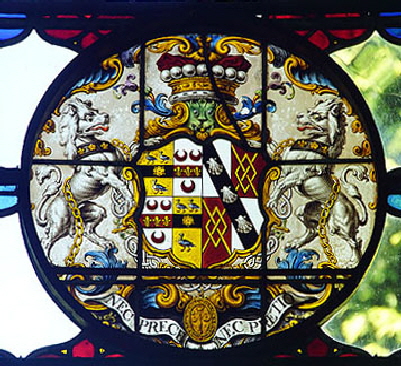 |
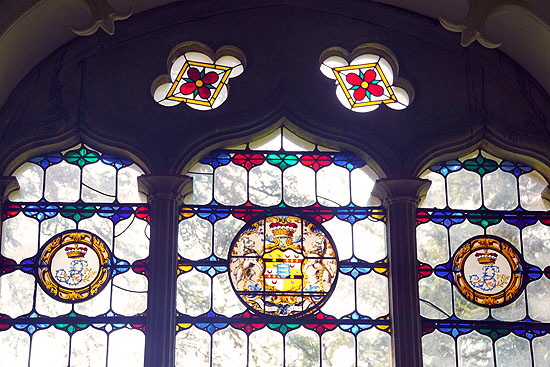 |
||||||||||||||||||||||||||||||||||||||||||||||||||||||||||||||||||||
|
Four Pictures Above: Original window glass in the north transept. The Batemans, of course would have been anxious to show off their lineage. Those of you who take interest in such things might wish to know that William Bateman, father of John, married Ann Spencer, daughter of the 3rd Duke of Sutherland, master of Althorp. The wedding took place in Blenheim Palace because Ann was also the granddaughter of John Churchill, the great Duke of Marlborough. I am sure that William felt he had “married well”. However, the marriage was not a success and in 1738 Ann returned to Althorp. In the picture lower left you can see a diagonal black band in the lower left hand quarter with three inverted scallop shells: this is part of the Spencer family arms. |
|||||||||||||||||||||||||||||||||||||||||||||||||||||||||||||||||||||
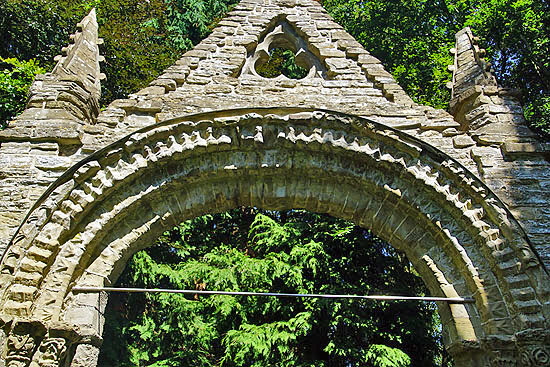 |
|||||||||||||||||||||||||||||||||||||||||||||||||||||||||||||||||||||
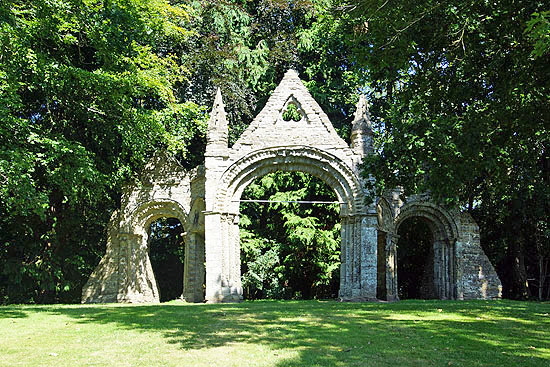 |
|||||||||||||||||||||||||||||||||||||||||||||||||||||||||||||||||||||
|
Left: The Shobdon Arches. The decorative “extras” don’t diminish the significance of the site. Right: The central arch was originally the church’s west doorway. |
|||||||||||||||||||||||||||||||||||||||||||||||||||||||||||||||||||||
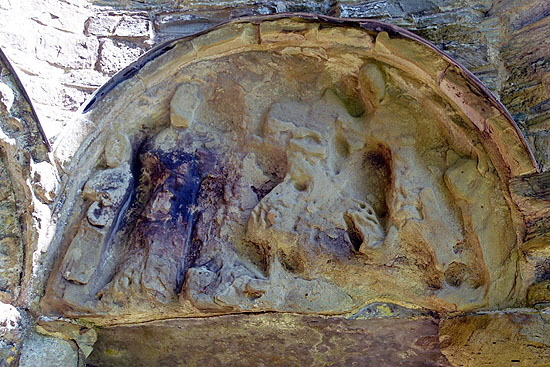 |
|||||||||||||||||||||||||||||||||||||||||||||||||||||||||||||||||||||
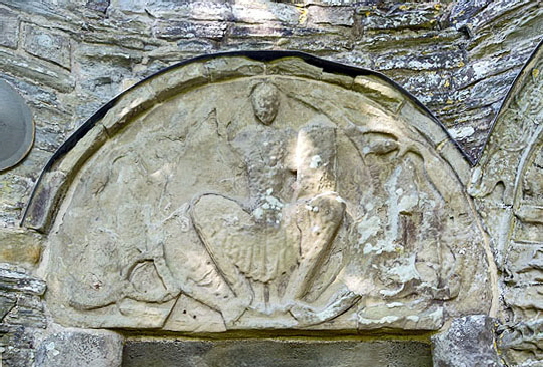 |
|||||||||||||||||||||||||||||||||||||||||||||||||||||||||||||||||||||
|
There are two tympani here - both grievously weathered and now more of interest within the wider context of the Herefordshire School than as objects in their own right. Left: This Christ in Majesty figure is from the south doorway. Right: The Harrowing of Hell. |
|||||||||||||||||||||||||||||||||||||||||||||||||||||||||||||||||||||
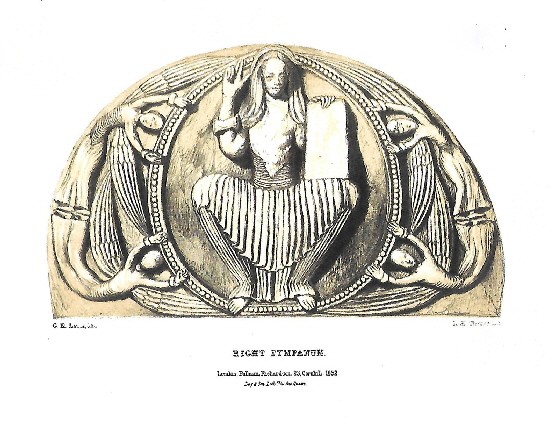 |
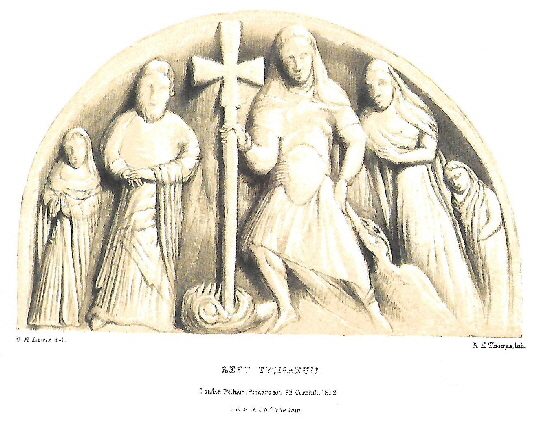 |
||||||||||||||||||||||||||||||||||||||||||||||||||||||||||||||||||||
|
We are very fortunate that we do not have to use our imaginations to decipher the badly weathered sculpture at Shobdon. One GR Lewis sketched the carvibgs in 1842 although it is said that they are not toyally reliable. Beggars can’t be choosers. Left: Christ in Majesty is just about discernible today so no controversy here. The composition makes it very obvious that the same sculptor produced the tympanum at Rowlestone. Right: This is a depiction of the so-called “Harrowing of Hell” where Christ descended into hell during the three days of his “death” and led the innocents from the clutches of Satan - an event for which, I believe, there is scant scriptural support. The Herefordshire School used this same story for the wonderful font at Eardisley, also in Herefordshire, although the sculptors were not the same. |
|||||||||||||||||||||||||||||||||||||||||||||||||||||||||||||||||||||
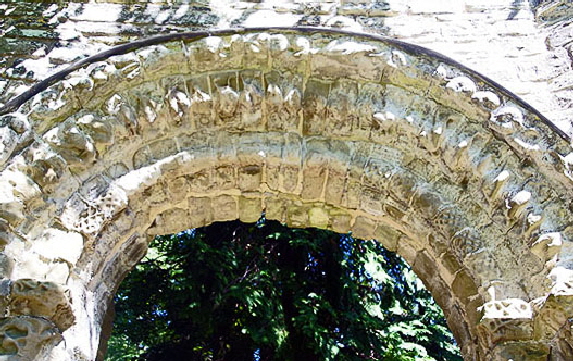 |
|||||||||||||||||||||||||||||||||||||||||||||||||||||||||||||||||||||
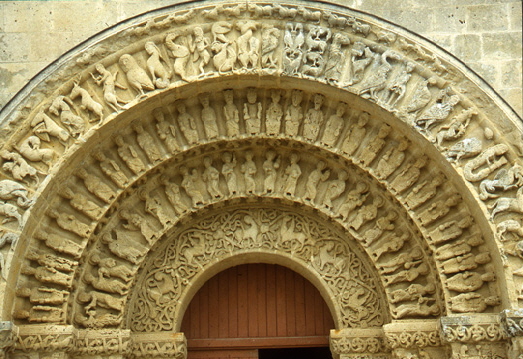 |
|||||||||||||||||||||||||||||||||||||||||||||||||||||||||||||||||||||
 |
 |
||||||||||||||||||||||||||||||||||||||||||||||||||||||||||||||||||||
|
Upper Left and Lower Left: The left arch is very badly weathered. Lewis’s drawings show that the decorations on Shobdon’s arches were arguably the finest surviving Norman sculptures in England until they were misguidedly (albeit with good intentions) moved to an exposed position. You can still see - just about - a little of the detail on the arch as it is now but it is clear that Lewis had much more to go on than do we. The outer course was composed of four serpents. The middle course has a whole series of spindly animals that are strangely reminiscent (to my eyes) of some of the Anglo-Saxon friezes at Breedon-on-the-Hill in Leicestershire. Upper Right: Malcolm Thurlby sees similarities between Shobdon’s left arch and the doorway at Aulnay-de-Daintonge. I suppose it is the spindly figures on the outer decorative course here that perhaps imitates the middle course at Shobdon. The subject matter also seems reminiscent of both the left and right arches at Shobdon. Whether one (presumably Shobdon) is imitative of the other is a matter of opinion. It might be just the case that where you have a very large number of sculptors working in widespread locations you are bound to get some random congruences. I am undecided on this one! Lower Right: Lewis’s drawing of the right arch. It is very similar in its artistic style to the left arch. The spindly beasts, however, are supplemented by slim erect figures that are, it must be said, very reminiscent of those on the Aulnay doorway. |
|||||||||||||||||||||||||||||||||||||||||||||||||||||||||||||||||||||
 |
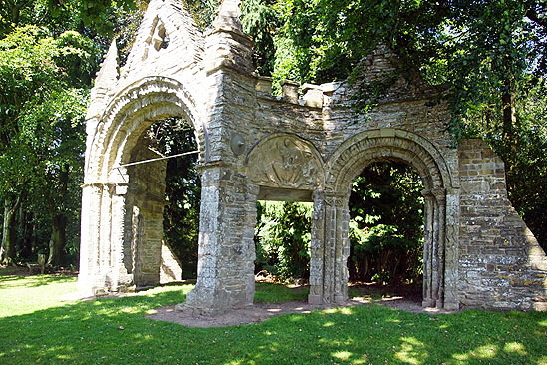 |
||||||||||||||||||||||||||||||||||||||||||||||||||||||||||||||||||||
|
Left: Detail of the outer (dragon) course of the right arch. Right: The arches from the right, with the Christ in Majesty tympanum centre. |
|||||||||||||||||||||||||||||||||||||||||||||||||||||||||||||||||||||
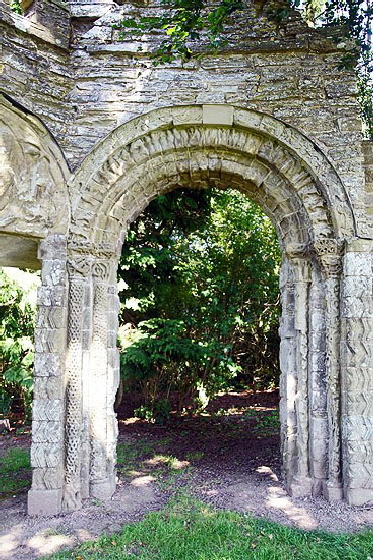 |
|||||||||||||||||||||||||||||||||||||||||||||||||||||||||||||||||||||
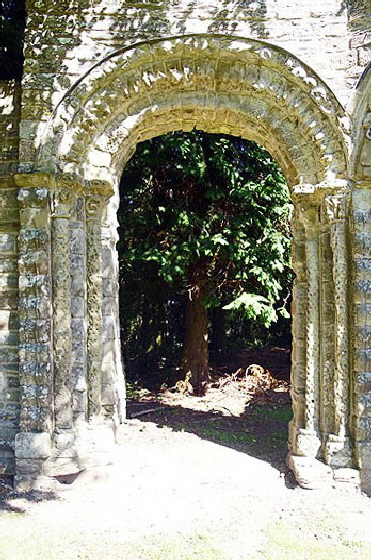 |
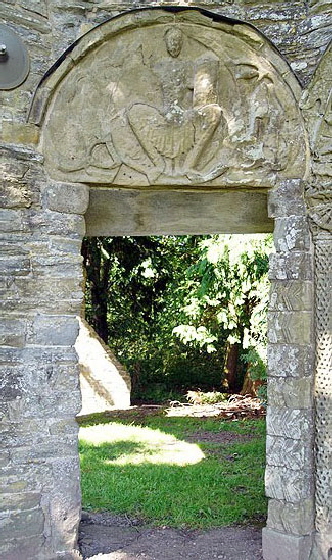 |
||||||||||||||||||||||||||||||||||||||||||||||||||||||||||||||||||||
|
Left: The right arch. Centre: The left arch. Note the elaborate capitals and pillars. Right: The Christ in Majesty tympanum in-situ. It is very obvious that both tympani were set above fake pillars and capitals and had been removed from the arches adjoining them. Presumably this was to facilitate a more elaborate five-part composition rather than a less spectacular one comprising the three arches in their entirety. |
|||||||||||||||||||||||||||||||||||||||||||||||||||||||||||||||||||||
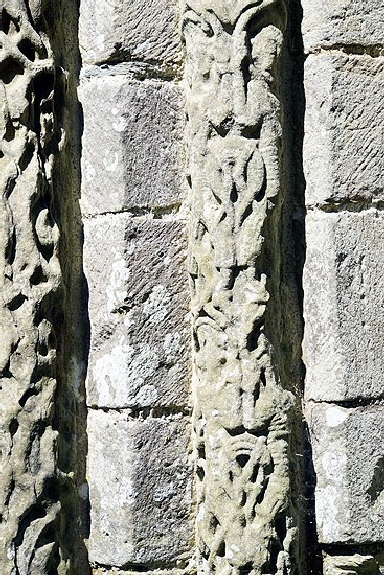 |
|||||||||||||||||||||||||||||||||||||||||||||||||||||||||||||||||||||
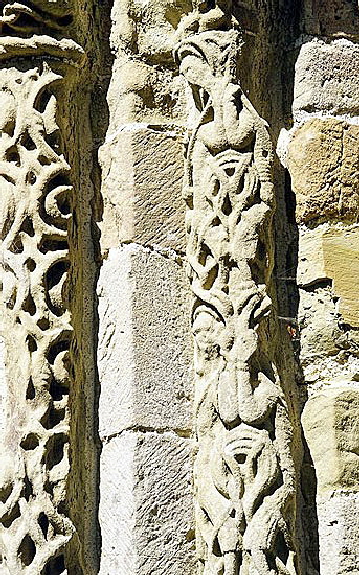 |
|||||||||||||||||||||||||||||||||||||||||||||||||||||||||||||||||||||
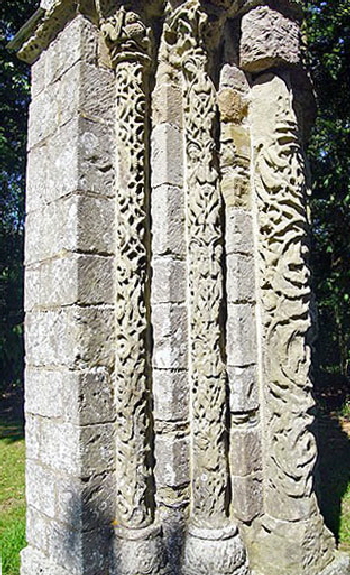 |
|||||||||||||||||||||||||||||||||||||||||||||||||||||||||||||||||||||
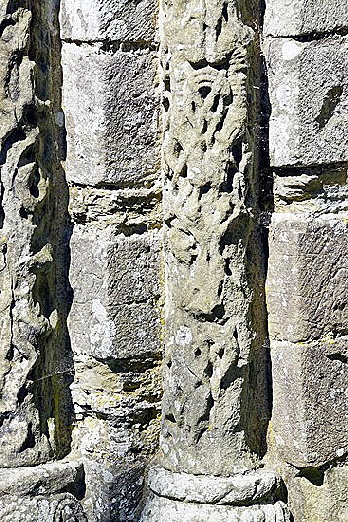 |
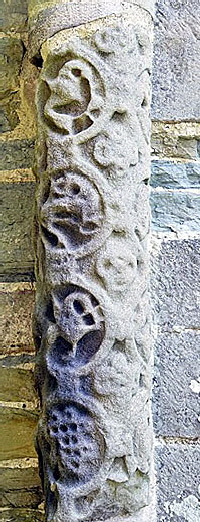 |
||||||||||||||||||||||||||||||||||||||||||||||||||||||||||||||||||||
 |
|||||||||||||||||||||||||||||||||||||||||||||||||||||||||||||||||||||
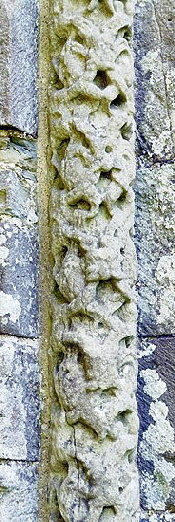 |
|||||||||||||||||||||||||||||||||||||||||||||||||||||||||||||||||||||
|
Pictures of the arch columns. You need to relate these - if you can - to some of GR Lewis’s drawings that I reproduce below. I haven’t been able to locate a full set. We can see enough here to know what we have lost. I believe there has been conservation work carried out on them in recent years in an effort to stabilise them. You can see here even now some of the iconic Herefordshire School designs. Looking at the pictures top centre and top right you can see examples of so-called “pipe cleaner” men. You can see examples in Lewis’s drawings below and see just how apt the designation is. There are similar figures at Kilpeck. In the picture second left lower you can see designs set in roundels that are again typical of - although not exclusive to - the Herefordshire School. |
|||||||||||||||||||||||||||||||||||||||||||||||||||||||||||||||||||||
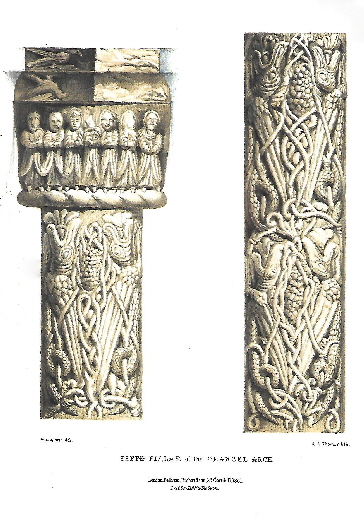 |
|||||||||||||||||||||||||||||||||||||||||||||||||||||||||||||||||||||
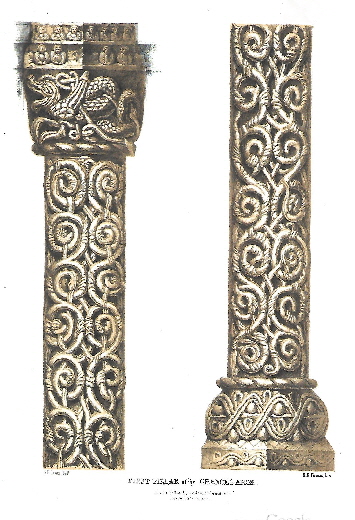 |
|||||||||||||||||||||||||||||||||||||||||||||||||||||||||||||||||||||
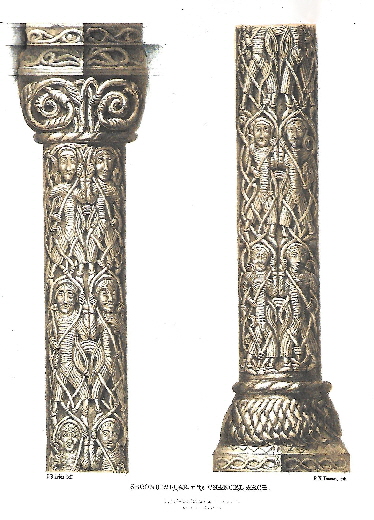 |
|||||||||||||||||||||||||||||||||||||||||||||||||||||||||||||||||||||
 |
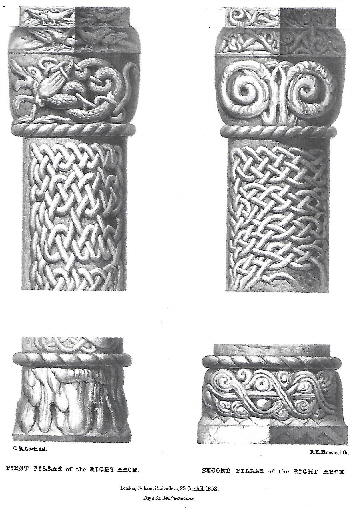 |
||||||||||||||||||||||||||||||||||||||||||||||||||||||||||||||||||||
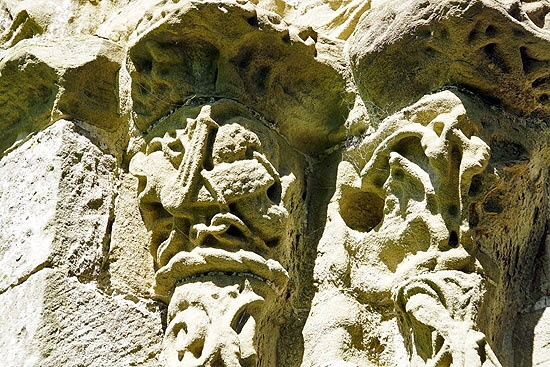 |
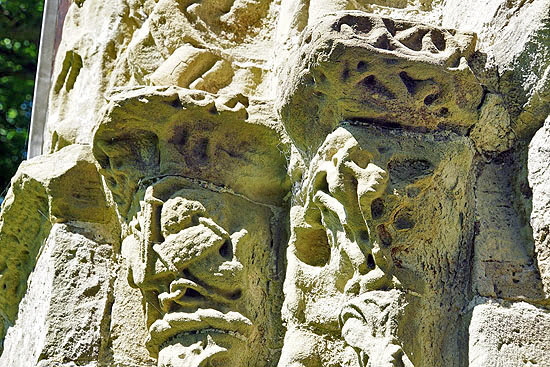 |
||||||||||||||||||||||||||||||||||||||||||||||||||||||||||||||||||||
|
Above Left and Right: The capitals on the pillars are arguably the most impressive parts of the arches. You can see that there is yet another example of the Herefordshire bird sculpture. |
|||||||||||||||||||||||||||||||||||||||||||||||||||||||||||||||||||||
 |
|||||||||||||||||||||||||||||||||||||||||||||||||||||||||||||||||||||
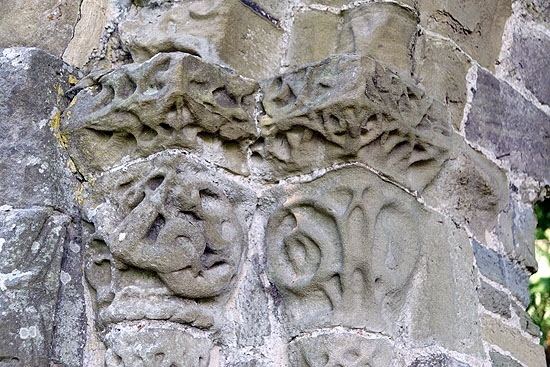 |
|||||||||||||||||||||||||||||||||||||||||||||||||||||||||||||||||||||
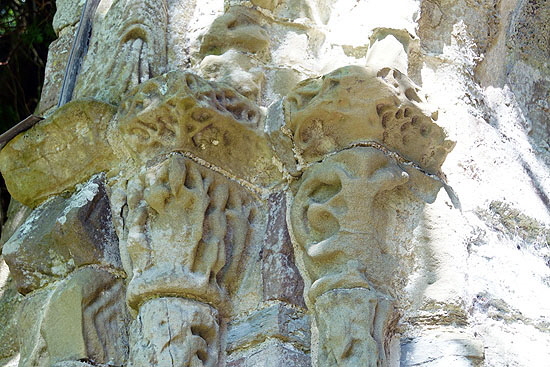 |
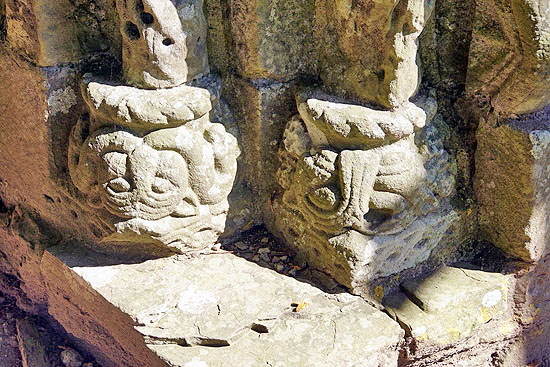 |
||||||||||||||||||||||||||||||||||||||||||||||||||||||||||||||||||||
|
Left: You can just about see that this capital represented a group of figures. Right: Unusually, the arches also have sculptural designs on their bases. In this case we see two upturned monster heads with the characteristic heavy multi-stranded brows and other facial features of the Herefordshire School and which you can see in the designs of the lions on the font. |
|||||||||||||||||||||||||||||||||||||||||||||||||||||||||||||||||||||
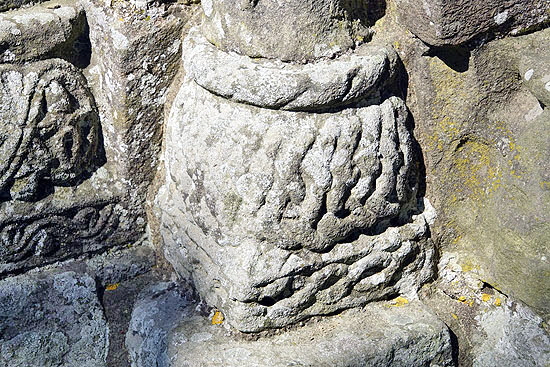 |
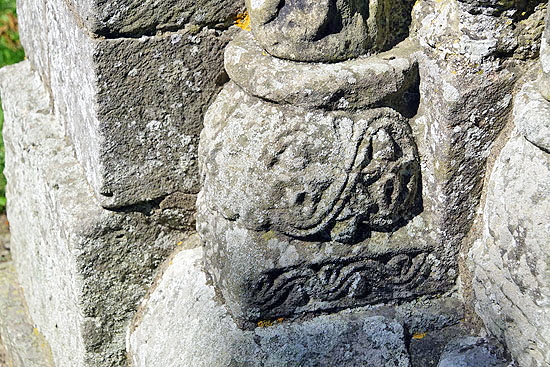 |
||||||||||||||||||||||||||||||||||||||||||||||||||||||||||||||||||||
|
More decorated pillar bases, this time with stylised designs. As you can see, no expense seems to have been spared at Shobdon. With Kilpeck it is the exemplar of the Herefordshire School. |
|||||||||||||||||||||||||||||||||||||||||||||||||||||||||||||||||||||